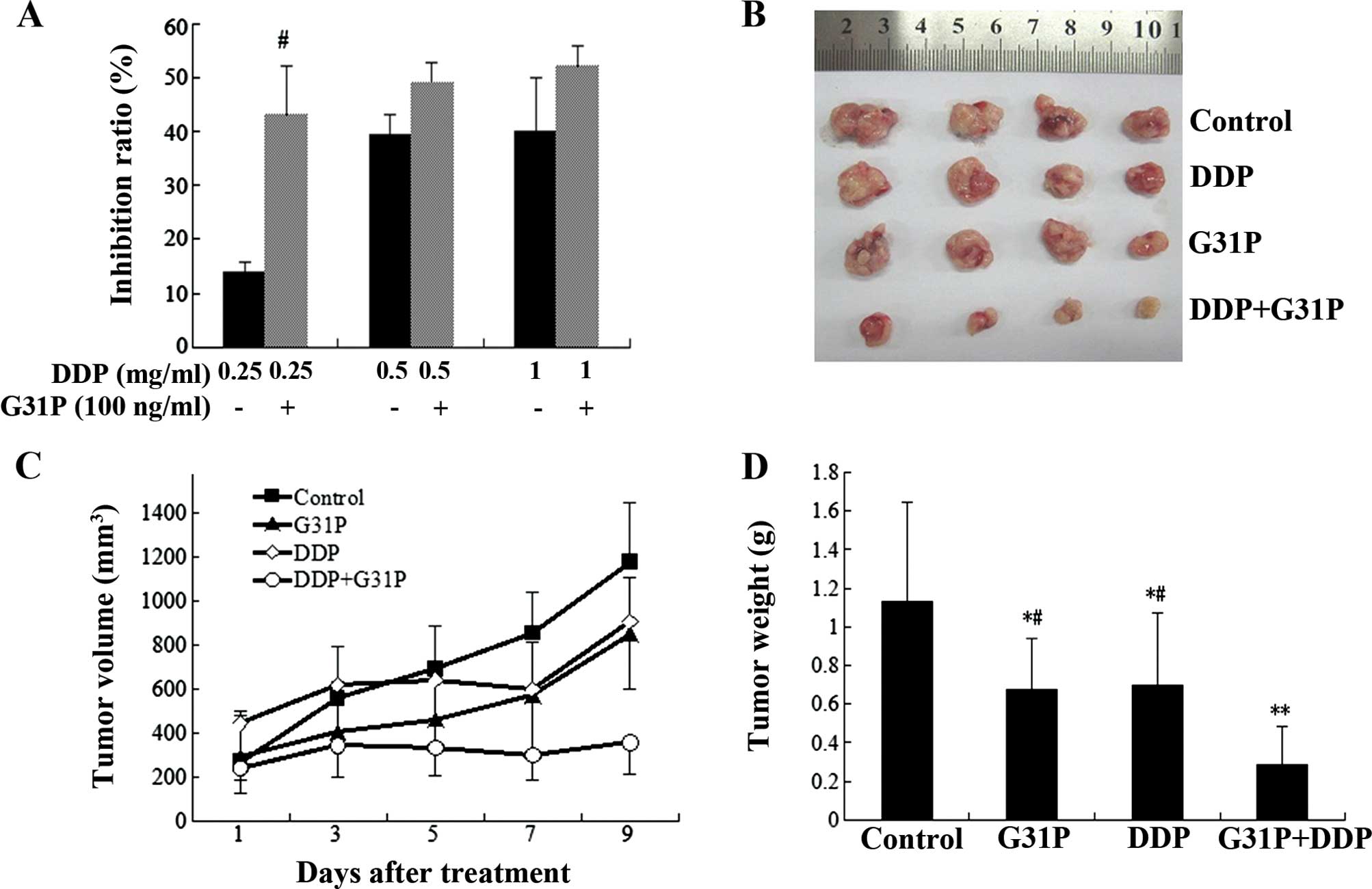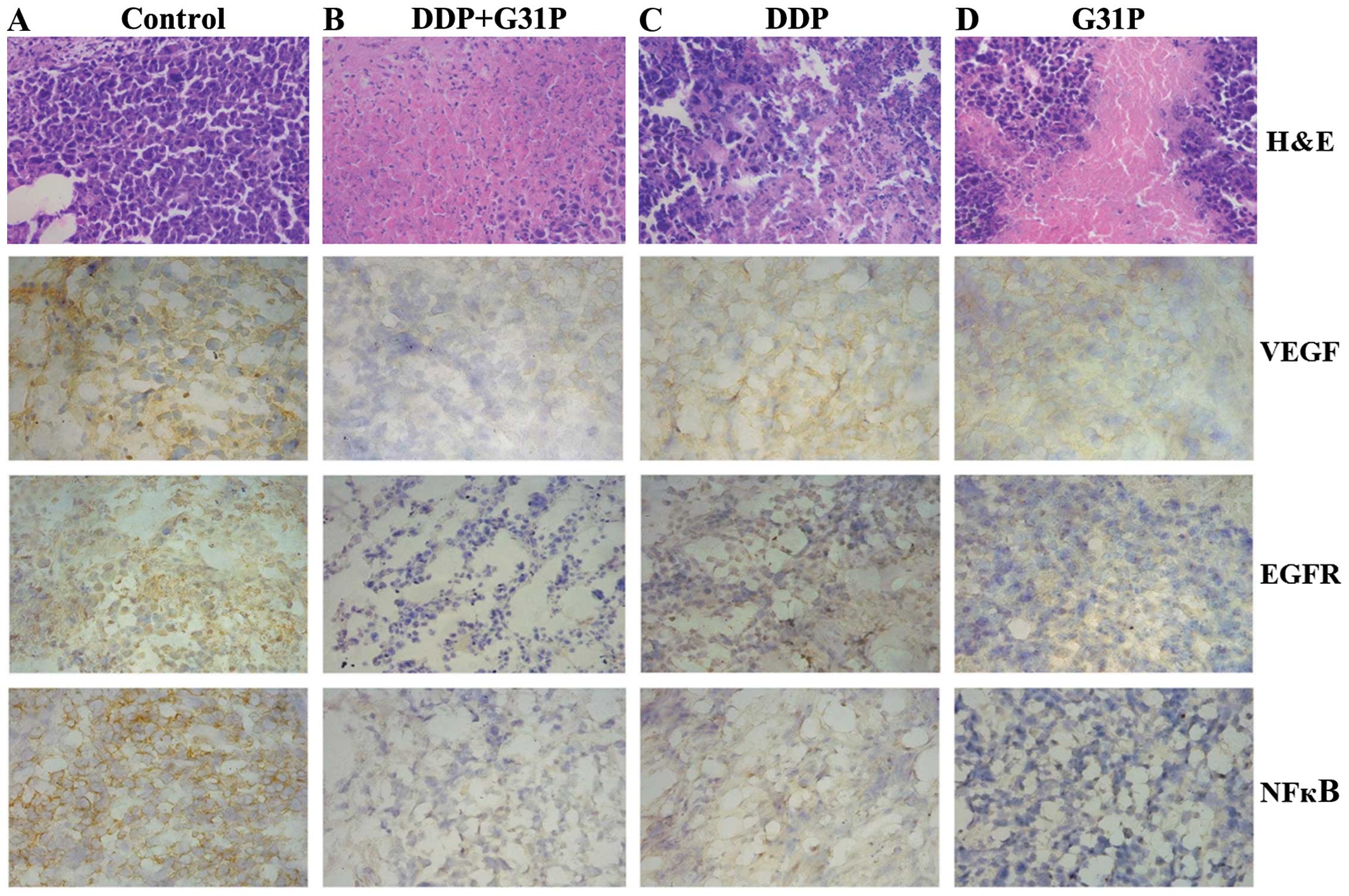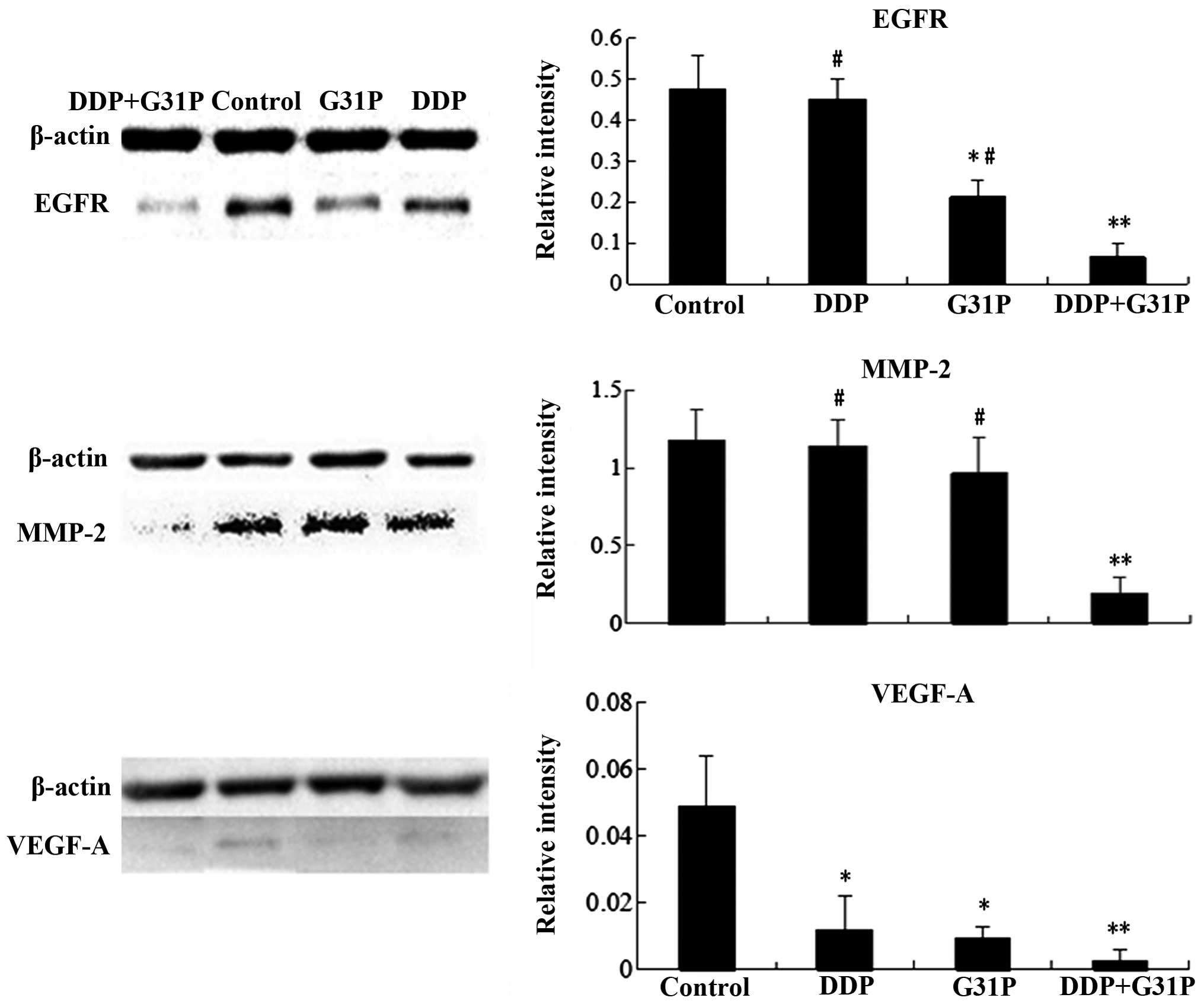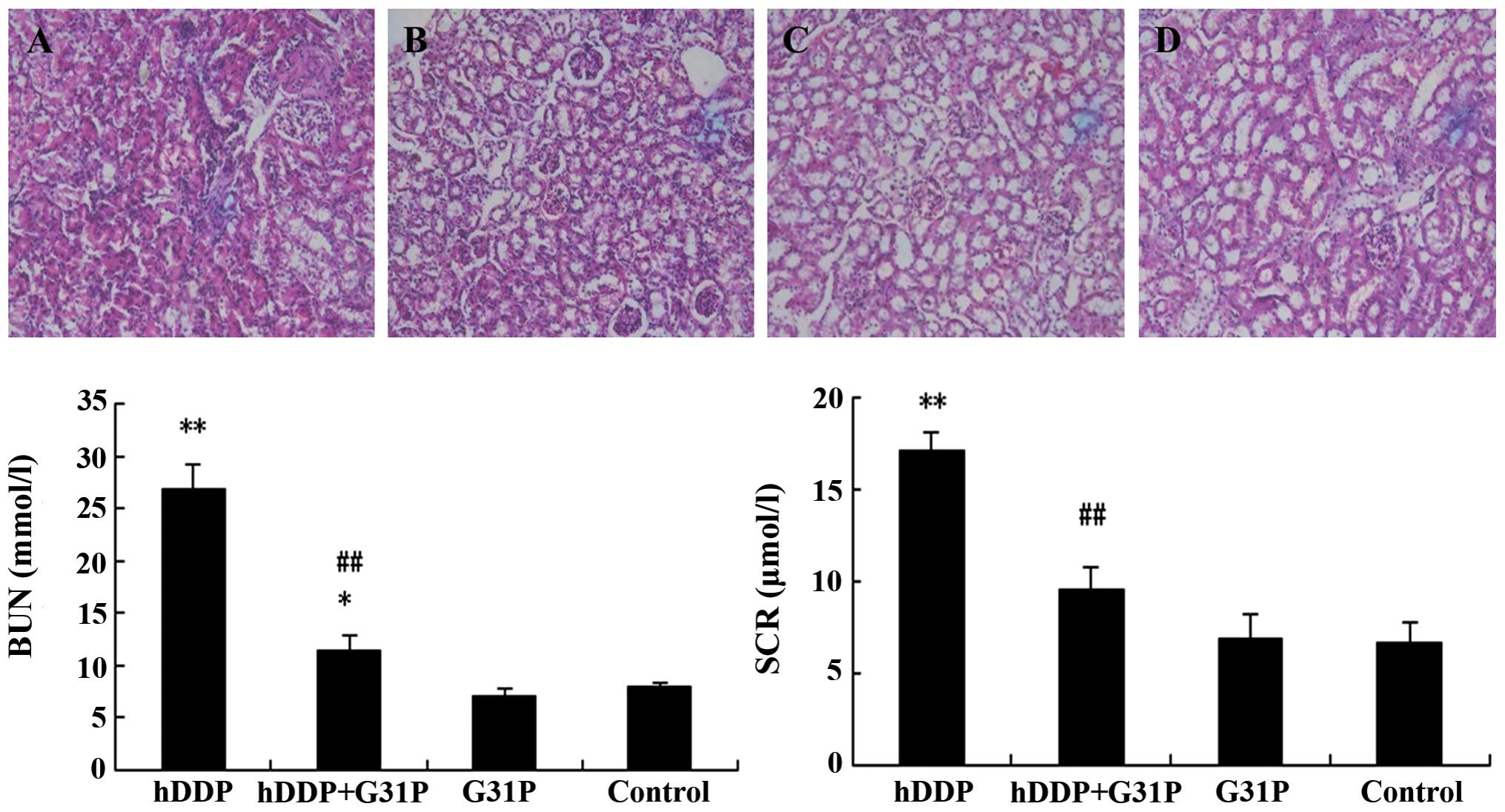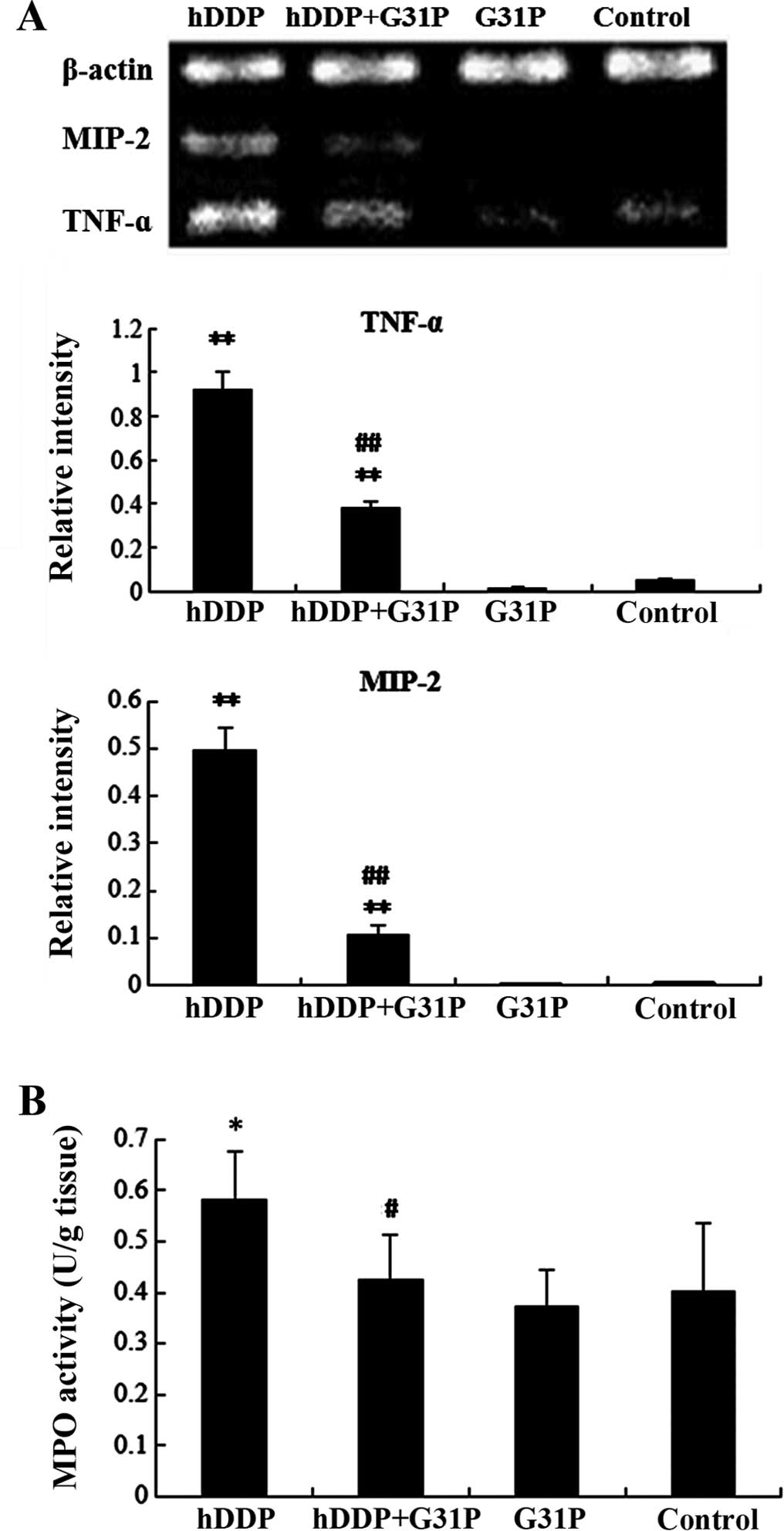|
1
|
Forner A, Llovet JM and Bruix J:
Hepatocellular carcinoma. Lancet. 379:1245–1255. 2012. View Article : Google Scholar : PubMed/NCBI
|
|
2
|
Shen FZ, Wang J, Liang J, Mu K, Hou JY and
Wang YT: Low-dose metronomic chemotherapy with cisplatin: can it
suppress angiogenesis in H22 hepatocarcinoma cells? Int J Exp
Pathol. 91:10–16. 2010. View Article : Google Scholar : PubMed/NCBI
|
|
3
|
Ozdogan O, Ertay T, Arslan G, et al: Does
cisplatin chemotherapy decrease the MDP uptake of normal bone? An
experimental study. Ann Nucl Med. 22:357–362. 2008. View Article : Google Scholar : PubMed/NCBI
|
|
4
|
Arany I and Safirstein RL: Cisplatin
nephrotoxicity. Semin Nephrol. 23:460–464. 2003. View Article : Google Scholar : PubMed/NCBI
|
|
5
|
Bonventre JV: Pathophysiology of ischemic
acute renal failure. Inflammation, lung-kidney cross-talk, and
biomarkers. Contrib Nephrol. 144:19–30. 2004. View Article : Google Scholar : PubMed/NCBI
|
|
6
|
Ramesh G and Reeves WB: TNFR2-mediated
apoptosis and necrosis in cisplatin-induced acute renal failure. Am
J Physiol Renal Physiol. 285:610–618. 2003.
|
|
7
|
Faubel S, Lewis EC, Reznikov L, Ljubanovic
D, Hoke TS, Somerset H, Oh DJ, Lu L, Klein CL, Dinarello CA and
Edelstein CL: Cisplatin-induced acute renal failure is associated
with an increase in the cytokines interleukin (IL)-1β, IL-18, IL-6,
and neutrophil infiltration in the kidney. J Pharmacol and Exp
Ther. 322:8–15. 2007. View Article : Google Scholar
|
|
8
|
Mukaida N: Pathophysiological roles of
interleukin-8/CXCL8 in pulmonary diseases. Am J Physiol Lung Cell
Mol Physiol. 284:L566–L577. 2003.PubMed/NCBI
|
|
9
|
Wang Y, Wang W, Wang L, Wang X and Xia J:
Regulatory mechanisms of interleukin-8 production induced by tumor
necrosis factor-α in human hepatocellular carcinoma cells. J Cell
Mol Med. 16:496–506. 2012. View Article : Google Scholar
|
|
10
|
Zhao X, Li F, Town JR, Zhang X, Wang W and
Gordon JR: Humanized forms of the CXCR1/CXCR2 antagonist, bovine
CXCL8(3-74)K11R/G31P, effectively block ELR-CXC
chemokine activity and airway endotoxemia pathology. Int
Immunopharmacol. 7:1723–1731. 2007. View Article : Google Scholar : PubMed/NCBI
|
|
11
|
Zhao X, Town JR, Li F, Zhang X, Cockcroft
DW and Gordon JR: ELR-CXC chemokine receptor antagonism targets
inflammatory responses at multiple levels. J Immunol.
182:3213–3222. 2009. View Article : Google Scholar : PubMed/NCBI
|
|
12
|
Gordon JR, Li F, Zhang X, Wang W, Zhao X
and Nayyar A: The combined CXCR1/CXCR2 antagonist
CXCL8(3-74)K11R/G31P blocks neutrophil infiltration,
pyrexia, and pulmonary vascular pathology in endotoxemic animals. J
Leukoc Biol. 78:1265–1272. 2005. View Article : Google Scholar : PubMed/NCBI
|
|
13
|
Zhao X, Town JR, Li F, Li W, Zhang X and
Gordon JR: Blockade of neutrophil responses in aspiration pneumonia
via ELR-CXC chemokine antagonism does not predispose to airway
bacterial outgrowth. Pulm Pharmacol Ther. 23:22–28. 2010.
View Article : Google Scholar
|
|
14
|
Zhao X, Town JR, Yang A, Zhang X, Paur N,
Sawicki G and Gordon JR: A novel ELR-CXC chemokine antagonist
reduces intestinal ischemia reperfusion-induced mortality, and
local and remote organ injury. J Surg Res. 162:264–273. 2010.
View Article : Google Scholar
|
|
15
|
Liu X, Peng J, Sun W, Yang S, Deng G, Li
F, Cheng JW and Gordon JR: G31P, an antagonist against CXC
chemokine receptors 1 and 2, inhibits growth of human prostate
cancer cells in nude mice. Tohoku J Exp Med. 228:147–156. 2012.
View Article : Google Scholar : PubMed/NCBI
|
|
16
|
Qin Y, Fan F, Zhao Y, Cui Y, Wei X, Kohama
K, Gordon JR, Li F and Gao Y: Recombinant human CXCL8 (3-72)
K11R/G31P regulates smooth muscle cell proliferation and migration
through blockage of interleukin-8 receptor. IUBMB Life. 65:67–75.
2013. View
Article : Google Scholar : PubMed/NCBI
|
|
17
|
Wei J, Peng J, Wang B, Qu H, Wang S,
Faisal A, Cheng JW, Gordon JR and Li F: CXCR1/CXCR2 antagonism is
effective in pulmonary defense against Klebsiella pneumoniae
infection. Biomed Res Int. 2013:7209752013. View Article : Google Scholar : PubMed/NCBI
|
|
18
|
Shen DW, Pouliot LM, Hall MD and Gottesman
MM: Cisplatin resistance: a cellular self-defense mechanism
resulting from multiple epigenetic and genetic changes. Pharmacol
Rev. 64:706–721. 2012. View Article : Google Scholar : PubMed/NCBI
|
|
19
|
Friedewald JJ and Rabb H: Inflammatory
cells in ischemic acute renal failure. Kidney Int. 66:486–491.
2004. View Article : Google Scholar : PubMed/NCBI
|
|
20
|
Okusa MD: The inflammatory cascade in
acute ischemic renal failure. Nephron. 90:133–138. 2002. View Article : Google Scholar : PubMed/NCBI
|
|
21
|
Wang W, Qin SK, Chen BA and Chen HY:
Experimental study on antitumor effect of arsenic trioxide in
combination with cisplatin or doxorubicin on hepatocellular
carcinoma. World J Gastroenterol. 7:702–705. 2001.
|
|
22
|
Yuan A, Chen JJ, Yao PL and Yang PC: The
role of interleukin-8 in cancer cells and microenvironment
interaction. Front Biosci. 10:853–865. 2005. View Article : Google Scholar
|
|
23
|
Xie K: Interleukin-8 and human cancer
biology. Cytokine Growth Factor Rev. 12:375–391. 2001. View Article : Google Scholar : PubMed/NCBI
|
|
24
|
Harimoto N, Shirabe K, Abe T, et al:
Interleukin-8 producing hepatocellular carcinoma with pyrexia. HPB
Surg. 1:461–492. 2009.
|
|
25
|
Yoong KF, Afford SC, Jones R, Aujla P, Qin
S, Price K, Hubscher SG and Adams DH: Expression and function of
CXC and CC chemokines in human malignant liver tumors: a role for
human monokine induced by gamma-interferon in lymphocyte
recruitment to hepatocellular carcinoma. Hepatology. 30:100–111.
1999. View Article : Google Scholar : PubMed/NCBI
|
|
26
|
Yang ZF and Poon RT: Vascular changes in
hepatocellular carcinoma. Anat Rec. 291:721–734. 2008. View Article : Google Scholar
|
|
27
|
Tanaka H, Yamamoto M, Hashimoto N,
Miyakoshi M, Tamakawa S, Yoshie M, Okusashi Y, Yokoyama K, Yaginuma
Y and Ogawa K: Hypoxia-independent overexpression of
hypoxia-inducible factor 1α as an early change in mouse
hepatocarcinogenesis. Cancer Res. 66:11263–11270. 2006. View Article : Google Scholar : PubMed/NCBI
|
|
28
|
Luppi F, Longo AM, de Boer WI, Rabe KF and
Hiemstra PS: Interleukin-8 stimulates cell proliferation in
non-small cell lung cancer through epidermal growth factor receptor
transactivation. Lung Cancer. 56:25–33. 2007. View Article : Google Scholar
|
|
29
|
Wu Y and Zhou BP: TNF-α/NF-κB/Snail
pathway in cancer cell migration and invasion. Br J Cancer.
102:639–644. 2010. View Article : Google Scholar : PubMed/NCBI
|
|
30
|
Guilpain P, Servettaz A, Batteux F,
Guillevin L and Mouthon L: Natural and disease associated
anti-myeloperoxidase (MPO) autoantibodies. Autoimmun Rev.
7:421–425. 2008. View Article : Google Scholar : PubMed/NCBI
|



